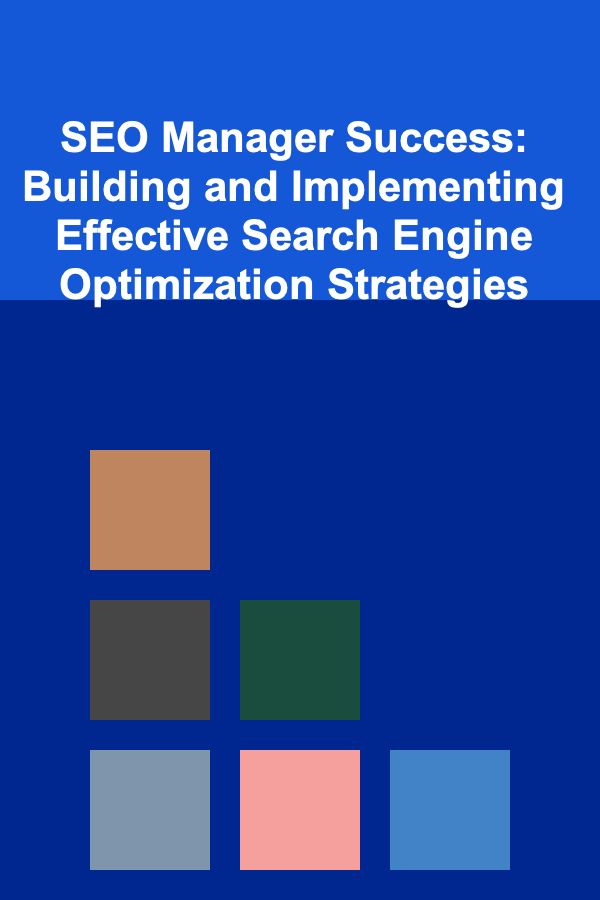
10 Tips for Segmenting Your Email List Like a Pro
ebook include PDF & Audio bundle (Micro Guide)
$12.99$10.99
Limited Time Offer! Order within the next:
Not available at this time

Email marketing remains one of the most powerful tools in a marketer's arsenal. However, simply sending out mass emails to a large list of recipients isn't enough to yield significant results. To truly maximize the effectiveness of your email campaigns, you need to take a more targeted, personalized approach. This is where email list segmentation comes in.
Segmentation is the practice of dividing your email list into smaller, more specific groups based on shared characteristics or behaviors. By sending tailored messages to these segmented groups, you increase the likelihood of engaging your audience and driving desired actions.
In this article, we'll explore 10 expert tips for segmenting your email list like a pro, ensuring that your campaigns are more effective, relevant, and ultimately, more profitable.
1. Understand the Importance of Email List Segmentation
Before diving into the tips, it's important to understand why segmentation is crucial to the success of your email marketing campaigns. Here's why it matters:
- Increased Engagement: Personalized emails resonate more with recipients. By sending targeted content, your emails will be more relevant, leading to higher open rates, click-through rates, and conversions.
- Better User Experience: Segmented emails deliver the right message at the right time, which enhances the overall customer experience. This fosters trust and loyalty.
- Higher Deliverability: Emails that are relevant and engaging are less likely to be marked as spam. This boosts your sender reputation and ensures your emails land in your recipients' inboxes.
- Improved ROI: Tailored content is more likely to convert. Whether you're selling products, promoting content, or encouraging sign-ups, segmentation leads to higher conversion rates and a better return on investment.
Now, let's dive into the tips for mastering email list segmentation.
2. Segment Based on Demographics
Demographic data is one of the most straightforward ways to segment your email list. This includes characteristics like age, gender, location, job title, income, and education level. By analyzing these factors, you can tailor your messaging to the specific needs of each demographic group.
How to Implement Demographic Segmentation:
- Age Groups: If you offer products or services that cater to a specific age range (e.g., products for young adults vs. seniors), segmenting your list by age allows you to deliver relevant content that resonates with each group.
- Location-Based Segmentation: If you have a geographically diverse audience, you can segment your list by region or city. This is especially useful for local promotions, event invitations, or location-specific offers.
- Gender-Specific Messaging: If your products are gender-specific, segment your list by gender to send relevant promotions. For instance, a fashion brand may want to send different emails to men and women.
3. Segment by Behavior and Interaction History
One of the most effective ways to segment your list is by using behavioral data. This includes past interactions with your emails, website activity, purchase history, and other behaviors that indicate a customer's level of interest or intent.
Behavioral Segmentation Examples:
- Engagement Level: Segment subscribers based on how actively they engage with your emails. For example:
- Highly Engaged Subscribers: Those who regularly open and click on your emails.
- Inactive Subscribers: Those who haven't engaged in a while. This group may benefit from a re-engagement campaign.
- Website Activity: Track the pages your subscribers visit on your website and segment them accordingly. For example, someone who visited your product page but didn't purchase may be interested in a special offer.
- Purchase History: If you sell products, segment your list based on what customers have purchased in the past. This allows you to recommend complementary products or offer loyalty discounts.
4. Segment by Subscriber Journey Stage
Your email list can also be segmented based on where a subscriber is in their customer journey. Whether they're a new lead, a long-time customer, or somewhere in between, your messaging should reflect their current stage and needs.
Customer Journey Segmentation Examples:
- Leads: For those who just signed up to your email list, send welcome emails, educational content, or introductory offers.
- New Customers: After a purchase, send onboarding emails, product usage tips, or a thank-you note.
- Repeat Customers: For loyal customers, offer exclusive deals, early access to new products, or loyalty rewards.
- Inactive Customers: Target those who haven't made a purchase in a while with special promotions or re-engagement campaigns.
5. Leverage Purchase Frequency and Recency
Segmenting based on how recently and how often someone has purchased from you allows you to target your most valuable customers and incentivize others to buy again.
How to Implement Recency and Frequency Segmentation:
- Recency: Segment based on how recently someone made a purchase. For example, customers who made a purchase in the last 30 days could receive a "thank you" email, while those who haven't purchased in 6 months might get a re-engagement offer.
- Frequency: Target frequent buyers with loyalty offers, while infrequent buyers might be incentivized with discounts or product recommendations.
6. Segment by Engagement with Previous Campaigns
Analyzing how subscribers interact with previous campaigns can provide valuable insights into their preferences and interests. Segmenting based on email engagement allows you to send more relevant content, increasing the likelihood of conversions.
How to Segment by Campaign Engagement:
- Open Rates: Those who regularly open your emails can be segmented into a highly engaged group, while those with lower open rates can be targeted with subject line testing or re-engagement offers.
- Click Rates: Subscribers who click on specific links can be segmented based on their interest in those topics or products. For instance, if someone clicked on a link to a particular product category, you can send them more offers related to that category.
7. Segment by Email Preferences
Allowing subscribers to set their email preferences can help you create highly tailored and segmented lists. By providing options for subscribers to choose what types of emails they want to receive (e.g., newsletters, promotional emails, event invitations), you can ensure that you're sending relevant content to the right people.
How to Implement Preference-Based Segmentation:
- Subscription Type: Offer different types of email subscriptions, such as promotional emails, event updates, or educational content, and let subscribers choose what they want to receive.
- Frequency Preferences: Some people may prefer weekly emails, while others prefer monthly updates. Letting subscribers choose the frequency can improve engagement and reduce unsubscribes.
8. Segment Based on Lead Scoring
Lead scoring is a system used to rank your leads based on their likelihood to convert. By assigning a score to each lead based on their behaviors (such as website visits, content downloads, or email opens), you can effectively prioritize your most promising leads.
How to Use Lead Scoring for Segmentation:
- High Lead Score: Segment those with high lead scores and send them targeted sales-oriented emails, such as exclusive offers or product demos.
- Low Lead Score: Subscribers with a low lead score may require more nurturing emails, such as educational content or introductory offers, before they're ready to convert.
9. Use A/B Testing for Further Refinement
A/B testing allows you to experiment with different subject lines, copy, images, or CTAs to see what resonates best with each segment. It can also help you refine your segmentation strategy by revealing which groups respond better to specific types of content.
How to Use A/B Testing for Segmentation:
- Subject Line Testing: Test different subject lines with different segments to see which ones achieve the best open rates.
- Content Variation: A/B test different types of content (e.g., discounts vs. product education) to determine what drives more clicks and conversions for each segment.
- Segment-Specific Campaigns: Use A/B testing within your segments to test the impact of personalized content.
10. Monitor and Adjust Your Segmentation Strategy
Email list segmentation is not a one-time process. As your business grows and your customers' preferences evolve, it's important to monitor the effectiveness of your segmentation strategy and make adjustments as needed.
How to Monitor and Adjust Segmentation:
- Analyze Performance Metrics: Regularly analyze the performance of your campaigns (open rates, click-through rates, conversion rates) to identify which segments are performing well and which are not.
- Adjust Segmentation Criteria: If certain segments are underperforming, consider adjusting your segmentation criteria or testing new ways to group your list.
- Conduct Surveys and Feedback: Ask your subscribers for feedback about the types of content they find valuable. Use this information to refine your segmentation.
Conclusion
Effective email list segmentation is a powerful way to maximize the impact of your email marketing campaigns. By understanding the importance of segmentation, leveraging demographic, behavioral, and engagement-based criteria, and continuously refining your strategy, you can create highly targeted and personalized emails that resonate with your audience.
With the tips outlined in this article, you can begin segmenting your email list like a pro. Whether you're aiming to improve engagement, boost sales, or strengthen relationships with your subscribers, segmentation provides a clear path to achieving your goals. Remember, personalization is key, and the more tailored your emails are to the specific needs and behaviors of your subscribers, the more successful your email campaigns will be.

How to Make a Spring Cleaning Checklist for Your Electronics
Read More
How to Make Money Online as an HVAC Technician: 10 Actionable Ideas
Read More
How to Plan a Kitchen Remodel with Minimal Disruption
Read More
How to Work with Small Business Owners to Understand Their Advertising Needs
Read More
SEO Manager Success: Building and Implementing Effective Search Engine Optimization Strategies
Read More
How to Design a Homeschool Planner for Different Learning Styles
Read MoreOther Products

How to Make a Spring Cleaning Checklist for Your Electronics
Read More
How to Make Money Online as an HVAC Technician: 10 Actionable Ideas
Read More
How to Plan a Kitchen Remodel with Minimal Disruption
Read More
How to Work with Small Business Owners to Understand Their Advertising Needs
Read More
SEO Manager Success: Building and Implementing Effective Search Engine Optimization Strategies
Read More